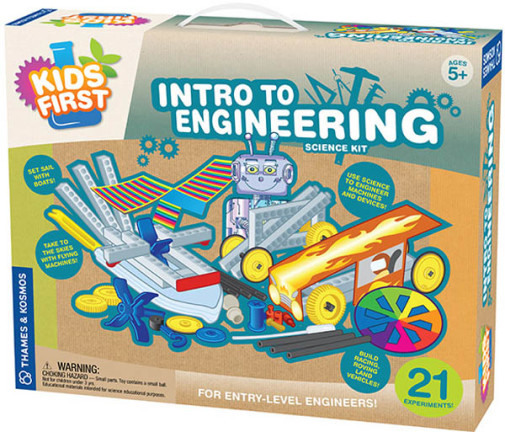We use cookies to make your experience better. To comply with the new e-Privacy directive, we need to ask for your consent to set the cookies. Learn more.
Intro to Engineering (Kids First Level 2)
Build 5 different types of projects beginning with engineering basics with levers, forces and pulleys. Explore engineering on land, air and water through building vehicles with wheels, a helicopter, parachute, balloon rocket, air-powered carousel, sailboat, paddle-boat, and more. Final projects focus on engineering at home with a model television and telephone, and creating a funny robot model. Teach engineering fundamentals with these engaging hands on experiments and building projects. Most supplies included, but you will need to add a few household items.
Intro to Engineering welcomes young children to the field of engineering with 25 experiments and building projects in five sections. By engaging in hands-on activities, children will learn how engineers apply their scientific and technical knowledge to design machines and devices.
Start by learning some engineering basics with experiments on levers, forces, and pulleys. Build simple devices using these basic components.
Move on to explore engineering on land by building vehicles with wheels, such as a race car and a wind-up car. Next, investigate engineering with air (and in the air) by building a helicopter, a pinwheel, a parachute, a glider, a balloon rocket, and an air-powered carousel. Then, build a diving bell, a sailboat, and a paddle boat to experiment with engineering in water.
Finally, find engineering in your own home with experiments modeling the telephone and television.
With a 48-page guidebook, Intro to Engineering teaches engineering fundamentals with step-by-step, hands-on experiments and building projects.
This great new series is for your youngest engineers and scientists. Level 1 is for ages 3 to 5, and level 2 is for 5 to 7. This is a brand new line for Thames and Kosmos and is intended to introduce young learners to science and math concepts while also developing fine motor skills and visual/spatial reasoning. At level 1, the building is accompanied by an engaging storybook (24 pages in length), pretend play, and simple activities. The activities reflect the content of the story line and use chunkier building pieces that are great for smaller hands. Each kit comes nicely packaged in a durable storage container.
Level 2 takes children to the next level of science there are no storybooks, but a detailed 48-page, illustrated guide book comes in every kit. These kits introduce children to the scientific method and teach science basics using hands-on experiments. Level 2 kits do not have a storage container.
| Product Format: | Other |
|---|---|
| Brand: | Thames and Kosmos |
| Grades: | K-2 |
| EAN/UPC: | 814743011342 |
| Length in Inches: | 11.625 |
| Width in Inches: | 14.625 |
| Height in Inches: | 3.25 |
| Weight in Pounds: | 1.5813 |

